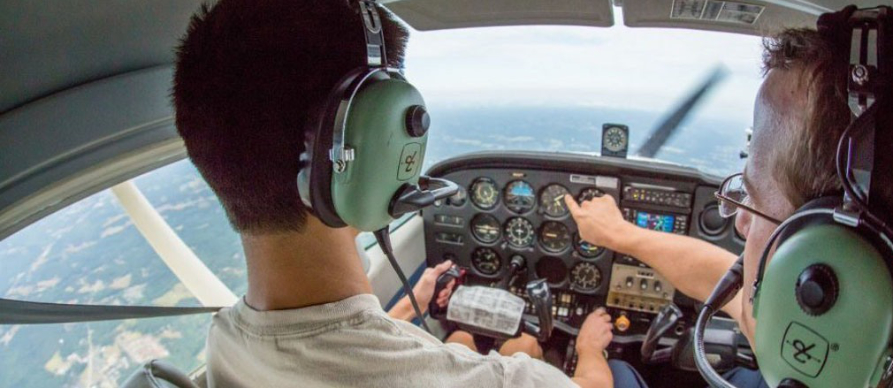
Becoming a private pilot requires fulfilling several requirements set by aviation authorities. In the United States, the Federal Aviation Administration (FAA) outlines these requirements in Part 61 of the Federal Aviation Regulations (FAR). Here are the key steps and requirements to obtain a Private Pilot Certificate:
Age Requirement:
 Be at least 17 years old.
Be at least 17 years old.
Language Proficiency:
 Be able to read, speak, write, and understand English.
Be able to read, speak, write, and understand English.
Medical Certification:
 Obtain at least a third-class medical certificate from an FAA-authorized aviation medical examiner.
Obtain at least a third-class medical certificate from an FAA-authorized aviation medical examiner.
Knowledge Test:
 Pass the FAA Private Pilot Knowledge Test (written exam) with a minimum score of 70%. The test includes questions on regulations, weather, navigation, and other pertinent topics.
Pass the FAA Private Pilot Knowledge Test (written exam) with a minimum score of 70%. The test includes questions on regulations, weather, navigation, and other pertinent topics.
Ground School:
 Complete ground school training, which can be done through a flight school, online courses, or self-study. Ground school covers topics like aerodynamics, weather, navigation, and FAA regulations.
Complete ground school training, which can be done through a flight school, online courses, or self-study. Ground school covers topics like aerodynamics, weather, navigation, and FAA regulations.
Flight Training:
 Accumulate a minimum of 40 hours of flight time, which must include:
Accumulate a minimum of 40 hours of flight time, which must include:
 20 hours of flight training with an instructor.
20 hours of flight training with an instructor.
 This includes at least 3 hours of cross-country flight training.
This includes at least 3 hours of cross-country flight training.
 3 hours of night flight training, including one cross-country flight over 100 nautical miles and 10 takeoffs and landings to a full stop at an airport.
3 hours of night flight training, including one cross-country flight over 100 nautical miles and 10 takeoffs and landings to a full stop at an airport.
 3 hours of instrument flight training.
3 hours of instrument flight training.
 3 hours of flight training in preparation for the practical test within the preceding two calendar months.
3 hours of flight training in preparation for the practical test within the preceding two calendar months.
 10 hours of solo flight time.
10 hours of solo flight time.
 This includes 5 hours of solo cross-country flying.
This includes 5 hours of solo cross-country flying.
 One solo cross-country flight of at least 150 nautical miles total distance, with full-stop landings at three points and one segment of at least 50 nautical miles between takeoff and landing locations.
One solo cross-country flight of at least 150 nautical miles total distance, with full-stop landings at three points and one segment of at least 50 nautical miles between takeoff and landing locations.
 Three takeoffs and landings to a full stop at an airport with an operating control tower.
Three takeoffs and landings to a full stop at an airport with an operating control tower.
Practical Test (Checkride):
 Successfully complete a practical test (checkride) with an FAA-designated pilot examiner. The checkride consists of:
Successfully complete a practical test (checkride) with an FAA-designated pilot examiner. The checkride consists of:
 An oral examination covering knowledge areas.
An oral examination covering knowledge areas.
 A flight test to demonstrate proficiency in flight maneuvers, navigation, and emergency procedures.
A flight test to demonstrate proficiency in flight maneuvers, navigation, and emergency procedures.
Logbook Endorsements:
 Obtain the necessary endorsements from a certified flight instructor in your logbook, confirming you have completed the required training and are prepared for the knowledge test and checkride.
Obtain the necessary endorsements from a certified flight instructor in your logbook, confirming you have completed the required training and are prepared for the knowledge test and checkride.
Compliance with FAR Part 61:
 Adhere to all applicable regulations under FAR Part 61, which governs the certification of pilots and flight instructors.
Adhere to all applicable regulations under FAR Part 61, which governs the certification of pilots and flight instructors.
Additional Considerations:
 Training Aircraft: The aircraft used for training must meet FAA requirements and be appropriate for the type of certificate sought.
Training Aircraft: The aircraft used for training must meet FAA requirements and be appropriate for the type of certificate sought.
 Flight Schools: Attending an FAA-approved flight school can streamline the process, but it is not mandatory. Independent flight instructors can also provide the required training.
Flight Schools: Attending an FAA-approved flight school can streamline the process, but it is not mandatory. Independent flight instructors can also provide the required training.
Training Options — Part 61 vs Part 141 Schools (61.61 thru 61.217)
The Part 61 approach allows the student and instructor the freedom to arrange the training according to the needs and schedule of the student.
Part 141 schools supply a more structured learning environment with set schedules, dedicated classrooms, and are directly supervised by the FAA. The benefit is that students can obtain certificates with less required hours.
PRIVATE certificate:
Part 61 requires 40 hours of training; vs
Part 141 requires 35 hours.
INSTRUMENT rating:
Part 61 requires 40 hours of training; vs
Part 141 requires 35 hours.
COMMERCIAL certificate:
Part 61 requires a total of 250 hours; vs
Part 141 requires a total of only 190 hours.
Meeting the requirements for the Private Pilot Practical test ensures that you have the necessary knowledge, skills, and experience to safely operate as a private pilot.
The process involves a combination of ground instruction, flight training, testing, and practical experience. By following these steps, aspiring pilots can achieve their goal of earning a Private Pilot Certificate.